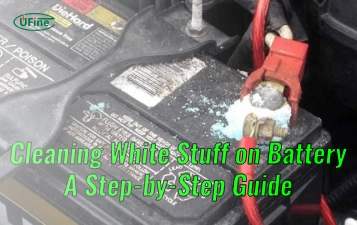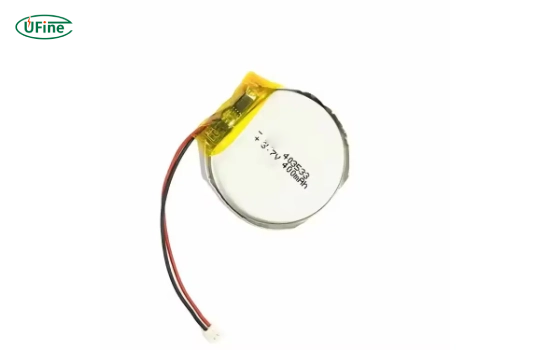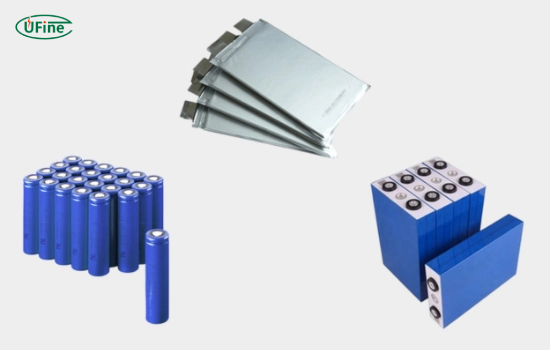Flat circle batteries and traditional lithium-ion cells are two prominent energy storage solutions powering modern technology, each with distinct advantages tailored to specific applications. This in-depth technical comparison explores their design, performance, safety, cost, and ideal use cases, providing engineers, consumers, and tech enthusiasts with actionable insights to choose the correct battery for their needs.
Part 1. What is a flat-circle battery?
A flat circle battery is a thin, disc-shaped lithium-based battery designed for compact electronics and wearables. Unlike cylindrical or prismatic cells, this battery has a flat, rounded profile that allows it to fit into smaller, sleeker devices.
Key characteristics:
- Shape: Flat and circular, like a coin.
- Chemistry: Typically lithium-based (e.g., Li-ion or Li-polymer).
- Applications: Smartwatches, hearing aids, RFID tags, medical devices, and compact IoT gadgets.
In short, flat circle batteries are built for space-saving and lightweight designs, whereas traditional batteries might be too bulky.
Part 2. What is a traditional lithium-ion battery?
A traditional lithium-ion battery is a rechargeable power source that leverages lithium ions moving between electrodes to store and release energy. These batteries come in three primary form factors:
- Cylindrical cells (e.g., 18650, 21700) resemble standard AA batteries but are larger.
- Prismatic cells feature a rectangular, rigid design for efficient space utilization.
- Pouch cells use flexible aluminium-plastic packaging for lightweight, customizable shapes.
Due to their high energy density and scalability, lithium-ion cells dominate high-energy applications such as electric vehicles (EVs), smartphones, laptops, power tools, and grid-scale energy storage.
Part 3. Flat circle battery vs. Traditional lithium-ion cells: Key differences in shape and size
The most striking difference between flat-circle batteries and traditional lithium-ion cells lies in their physical design:
Flat Circle Batteries
- Shape: Circular, resembling a coin or button.
- Thickness: Extremely slim, often under 5 mm.
- Volume Efficiency: Optimized for minimal space, ideal for ultra-compact devices.
- Weight: Lightweight, often weighing less than 10 grams.
Traditional Lithium-Ion Cells
- Shape: Cylindrical, prismatic, or pouch-based.
- Thickness: Varies widely; cylindrical cells can exceed 65 mm in height, while pouch cells are flat but bulkier than flat circle designs.
- Volume Efficiency: Prioritizes energy capacity over compactness.
- Weight: Heavier due to larger size and higher material volume.
Comparison Table: Shape and Size Differences
| Feature | Flat Circle Battery | Traditional Lithium-Ion Cell |
|---|---|---|
| Shape | Coin-like, circular | Cylindrical, prismatic, pouch |
| Thickness | 1–5 mm | 5–65 mm (varies by type) |
| Weight | <10 grams | 20–500 grams |
| Volume Efficiency | High for micro-devices | High for large-scale systems |
Part 4. Flat circle battery vs. Traditional lithium-ion cells: Energy density comparison
Energy density—measured in watt-hours per litre (Wh/L)—determines how much energy a battery can store relative to its size.
- Flat Circle Batteries: These batteries sacrifice energy density for compactness. Typical values range from 200 to 350 Wh/L, suitable for low-power devices with intermittent usage.
- Traditional Lithium-Ion Cells: Designed for high energy output, they achieve 250–700 Wh/L, with cylindrical cells (e.g., 21700) leading the pack. This makes them indispensable for EVs and devices requiring sustained power.
Why It Matters: Traditional cells’ high energy density supports longer runtimes and faster charging, while flat circle batteries prioritize portability over capacity.
Part 5. Flat circle battery vs. Traditional lithium-ion cells: Lifespan and durability
Battery lifespan depends on charge cycles, operating conditions, and maintenance.
- Flat Circle Batteries: Typically endure 300–500 charge cycles before capacity drops to 80%. Their small size limits heat dissipation, accelerating degradation under heavy loads or extreme temperatures.
- Traditional Lithium-Ion Cells: Advanced thermal management and robust materials enable 1,000–3,000+ cycles. For example, EV batteries often retain 80% capacity after 8–10 years of use.
Pro Tip: Avoid deep discharges and high temperatures to maximize the lifespan of both battery types.
Part 6. Flat circle battery vs. Traditional lithium-ion cells: Safety considerations
Safety is critical, especially in high-energy applications.
- Flat Circle Batteries: Their low energy output minimizes risks like thermal runaway. However, improper handling (e.g., puncturing) can still cause leaks or fires.
- Traditional Lithium-Ion Cells: Require multi-layered safety mechanisms, including:
- Battery Management Systems (BMS) will monitor voltage and temperature.
- Pressure relief vents in cylindrical cells.
- Flame-retardant electrolytes in pouch cells.
Recent Innovations: Solid-state lithium-ion batteries promise enhanced safety for both types by replacing flammable liquid electrolytes with solid alternatives.
Part 7. Flat circle battery vs. Traditional lithium-ion cells: Performance in extreme temperatures
Temperature extremes impact efficiency and longevity.
- Flat Circle Batteries: Perform poorly outside 0°C to 40°C. Cold weather slows ion movement, reducing output, while heat accelerates chemical degradation.
- Traditional Lithium-Ion Cells: Operate effectively in -20°C to 60°C ranges, thanks to advanced thermal management in systems like EVs. For instance, Tesla’s battery packs use liquid cooling to maintain optimal temperatures.
Application Insight: Flat circle batteries are unsuitable for outdoor gear in harsh climates, whereas traditional cells excel in automotive and industrial settings.
Part 8. Flat circle battery vs. Traditional lithium-ion cells: Charging speed and efficiency
Charging capabilities vary significantly:
- Flat Circle Batteries: Because of their small size, flat circle batteries charge slowly (0.5–1C rates) to prevent overheating. A 100 mAh coin cell may take 2–3 hours to charge.
- Traditional Lithium-Ion Cells: Support fast charging (1–4C rates) with minimal heat generation. For example, smartphones use 20W+ charging to reach 50% capacity in 30 minutes.
Future Trends: Silicon-anode and graphene technologies aim to boost charging speeds for both battery types without compromising safety.
Part 9. Flat circle battery vs. Traditional lithium-ion cells: Cost analysis
Cost-effectiveness depends on scale and application.
- Flat Circle Batteries: Cheap to manufacture ($0.50–$5 per unit) due to simple designs and mass production. Ideal for disposable or low-cycle devices like calculators.
- Traditional Lithium-Ion Cells: Higher upfront cost ($50–$200 per kWh) but better long-term value for energy-intensive applications. EVs benefit from falling prices, now nearing $100/kWh for pack-level costs.
Economic Note: Recycling initiatives for lithium-ion cells are reducing costs and environmental impact, while flat-circle batteries face challenges due to their niche use cases.
Part 10. Choosing the correct battery for your application
Selecting between these batteries hinges on your project’s requirements:
Flat Circle Batteries Are Ideal For:
- Wearables (smartwatches, fitness trackers).
- Medical devices (hearing aids, implantable sensors).
- Microelectronics (IoT sensors, RFID tags).
Traditional Lithium-Ion Cells Excel In:
- Consumer electronics (smartphones, laptops).
- Electric vehicles and hybrid systems.
- Renewable energy storage (solar, wind).
- High-drain tools (drills, drones).
Hybrid Solutions: Some devices, like premium smartwatches, combine flat-circle batteries for compactness with small lithium-ion packs for extended functionality.
Part 11. FAQs about flat circle batteries and traditional lithium-ion cells
Can flat-circle batteries replace traditional lithium-ion cells in smartphones?
No. Due to size limitations, smartphones require high energy density and fast charging, which flat-circle batteries cannot provide.
Are flat-circle batteries recyclable?
Yes, but recycling rates are low due to their small size and mixed-material construction. Traditional lithium-ion cells have more established recycling pipelines.
Which battery type is more environmentally friendly?
Traditional lithium-ion cells have a larger carbon footprint during production but offset this through long lifespans and recyclability. Flat circle batteries, while more minor, often end up in landfills due to disposal challenges.
Do flat-circle batteries work in extreme humidity?
They are sensitive to moisture. Use sealed or waterproof devices to prevent corrosion and failure.
What advancements are expected in flat-circle battery technology?
Research focuses on solid-state designs and higher energy densities to expand their use in emerging tech like flexible electronics and miniaturized robotics.
Related Tags:
More Articles

White Stuff on Battery Terminals: A Step-by-Step Cleaning and Maintenance Guide
White stuff on battery terminals is corrosion. Learn how to clean it safely, prevent damage, and keep your battery running strong with simple steps.
Understanding How Glass Mat Batteries Work: Technology, Benefits, and Limitations
Glass mat batteries power cars, RVs, and solar systems. Learn how they work, their benefits, and what to consider before choosing one.
A Buyer’s Guide for AA Size Lithium Battery
Discover the power of AA size lithium batteries—types, voltage, capacity, and more! Learn how to choose the best one for your needs. Read now!
Li-Ion Battery Prices – Where to Buy Cheap & Safe
Discover li-ion cell prices, key market factors, and how to find affordable custom batteries from top suppliers like Ufine Battery.
How Long Does a 2200mAh Battery Last?
Discover everything about 2200mAh batteries—types, charging time, lifespan, and whether it’s enough for your device.





